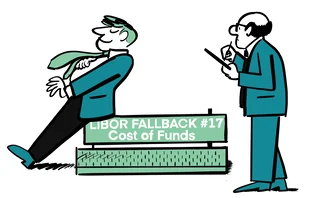
Secrets and Libor fallbacks
Lenders may be forced to reveal sensitive funding data when Libor disappears
Some things are better not shared. Like shoes, Risk.net logins and a bank’s cost of funds. Lenders may be forced to reveal this closely guarded information, however, when Libor ceases to be published.
Cost of funds is the ultimate interest rate fallback in the Loan Market Association’s standard documentation, which is widely used for syndicated and bilateral corporate loans governed by UK and European law.
There are several problems with this. First, the LMA documentation does not define cost of funds or how it should be calculated. Given its use as a proxy for Libor, the term is generally interpreted as the cost of borrowing in the short-term interbank markets. But banks no longer fund themselves in this way. According to the Bank of England, the proportion of balance sheet assets reliant on wholesale funding dropped from more than 40% in 2008 to less than 25% in 2017.
As a result, most banks now factor in other liabilities, such as retail deposits and long-term debt, when calculating their overall funding costs for lending. Some may even argue that loan loss reserves and capital requirements should be included in the costs passed on to lenders.
Even if a common approach to measuring cost of funds could be agreed, banks want to keep that information tightly sealed. A lender with low funding costs may face a backlash from customers for charging higher rates. More worryingly, a bank that pays above the odds would face questions about its creditworthiness and find itself locked out of the funding markets altogether.
All of this means cost of funds simply isn’t going to fly as a Libor fallback for loans. “I cannot ever envision individual banks publishing cost of funds,” says the head of credit and lending at an international bank. “That would not happen, full stop.”
Banks are now scrambling to insert alternative fallbacks into loan agreements. That’s easier said than done. While derivatives will switch to a compounded-in-arrears version of new risk-free rates plus a fixed spread, the loan market is clamouring for forward-looking term rates with a spread adjustment that more closely mirrors the credit component of Libor. These may take some time to emerge.
In the UK, forward-looking term versions of Sonia, the sterling Libor replacement, won’t be available for use until the end of the third quarter. In December, the working group on sterling risk-free reference rates launched a consultation on credit adjustment spread methodologies for fallbacks in cash products, which is likely to take even longer to conclude.
Some are now suggesting the loan market should simply adopt the fallbacks for derivatives instead. But the International Swaps and Derivatives Association’s fallback methodology fixes the effective bank term lending or credit component, and will create winners and losers when used as a reference rate for long-term assets.
This should in theory be subject to compensation. But as Marc Henrard, managing partner at muRisQ Advisory writes, this is by no means a straightforward calculation, as shown in the non-cleared swaps market.
Using basis levels from before the Isda fallback consultations started moving the market, Henrard shows that a 30-year Libor swap rate without fallbacks should be up to 10 basis points higher than current levels.
All this involves complicated modelling, which might be ok to explain to a derivatives counterparty, but perhaps not to a small business owner wondering why the bank wants to change the terms of a loan. And if a dispute over compensation goes to court, Henrard believes a judge would throw out the Isda fallback in favour of a benchmark with a dynamic credit risk that changes over time, such as Ice Benchmark Administration’s bank yield index or Ameribor.
Libor fallbacks, like shoes and logins, are perhaps better not shared. Banks will need to find an appropriate alternative to cost of funds in loan agreements, and quickly.
Only users who have a paid subscription or are part of a corporate subscription are able to print or copy content.
To access these options, along with all other subscription benefits, please contact info@risk.net or view our subscription options here: http://subscriptions.risk.net/subscribe
You are currently unable to print this content. Please contact info@risk.net to find out more.
You are currently unable to copy this content. Please contact info@risk.net to find out more.
Copyright Infopro Digital Limited. All rights reserved.
As outlined in our terms and conditions, https://www.infopro-digital.com/terms-and-conditions/subscriptions/ (point 2.4), printing is limited to a single copy.
If you would like to purchase additional rights please email info@risk.net
Copyright Infopro Digital Limited. All rights reserved.
You may share this content using our article tools. As outlined in our terms and conditions, https://www.infopro-digital.com/terms-and-conditions/subscriptions/ (clause 2.4), an Authorised User may only make one copy of the materials for their own personal use. You must also comply with the restrictions in clause 2.5.
If you would like to purchase additional rights please email info@risk.net
More on Our take
Quants dive into FX fixing windows debate
Longer fixing windows may benefit clients, but predicting how dealers will respond is tough
Talking Heads 2024: All eyes on US equities
How the tech-driven S&P 500 surge has impacted thinking at five market participants
Beware the macro elephant that could stomp on stocks
Macro risks have the potential to shake equities more than investors might be anticipating
Podcast: Piterbarg and Nowaczyk on running better backtests
Quants discuss new way to extract independent samples from correlated datasets
Should trend followers lower their horizons?
August’s volatility blip benefited hedge funds that use short-term trend signals
Low FX vol regime fuels exotics expansion
Interest is growing in the products as a way to squeeze juice out of a flat market
Can pod shops channel ‘organisational alpha’?
The tension between a firm and its managers can drag on returns. So far, there’s no perfect fix
CDS market revamp aims to fix the (de)faults
Proposed makeover for determinations committees tackles concerns over conflicts of interest









